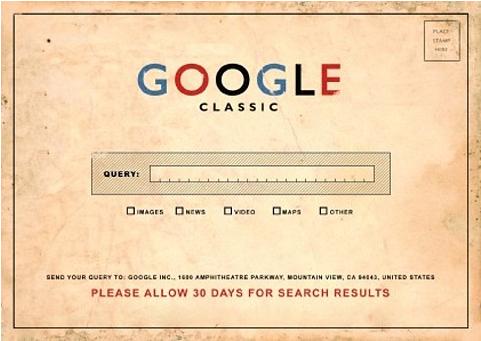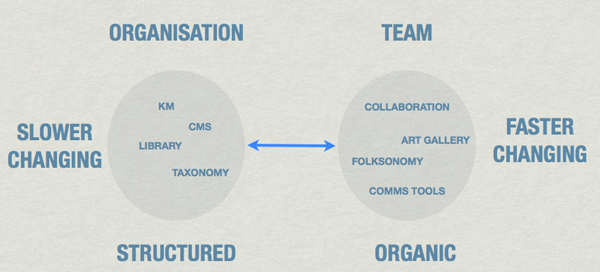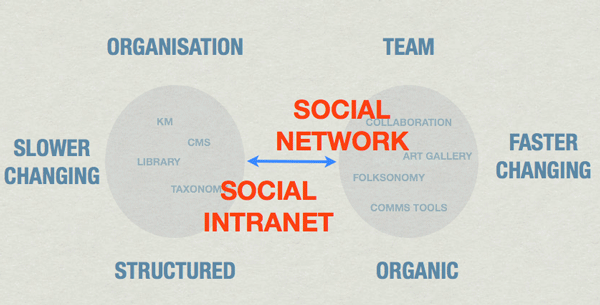Category: Enterprise 2.0
An intriguing article on Management Exchange looking at what the author Gary Hemel sees as the 12 characteristics of the “Facebook Generation“. I’m personally reluctant to adopt a generational breakdown of online activity, not least because the data is patchy and what there is points to corporate culture being more important than the age of users. Nonetheless, I think the following has some salient points:
The experience of growing up online will profoundly shape the workplace expectations of “Generation F” – the Facebook Generation. At a minimum, they’ll expect the social environment of work to reflect the social context of the Web, rather than as is currently the case, a mid-20th-century Weberian bureaucracy.
Hemel’s dozen needs to be read in full to do it justice, not least the last one on hackers, but here it is in truncated as headers:
1. All ideas compete on an equal footing.
2. Contribution counts for more than credentials.
3. Hierarchies are natural, not prescribed.
4. Leaders serve rather than preside.
5. Tasks are chosen, not assigned.
6. Groups are self-defining and self-organizing.
7. Resources get attracted, not allocated.
8. Power comes from sharing information, not hoarding it.
9. Opinions compound and decisions are peer-reviewed.
10. Users can veto most policy decisions.
11. Intrinsic rewards matter most.
12. Hackers are heroes.
If we look at this from a distance, the presiding shift is one of organisational power from the hierarchy to the individual and the team. The traditional structure of the Weberian or Fordist enterprise does not follow that pattern. Indeed, the most successful businesses still of course largely follow that pattern. Is there therefore a tectonic clash emerging between old and new? I personally doubt that, at least in any short terms view of economic structures. There is however a need seen here for organisations to take heed of these trends and to look at ways of adoption that adapt. To some extent this entails a change in culture that really is just that: a change in the very culture of how they operate. And it’s for that reason that introducing Enterprise 2.0 into a corporation is never straightforward or easy….
Refs
Why IBM Could Be Bigger Than Facebook in Social Media
I like the fact that IBM stress simplicity and usability tied into a solid business need. The Fast Company comment is salient:
Regardless of your business size, IBM’s big move into social software should be a clear indication that every business needs a broad-reaching social strategy not just a Facebook fan page! This strategy needs to address the needs of your customers and your employees, ensuring optimal collaboration between them anytime and anywhere.
If anyone can introduce me to Jeffrey Schick, let me know as I’d like to send him my CV 😉
Andrew McAfee & O’Reilly talk about Social Media and Enterprise 2.0. Not very often that I’ll post a video simply as that (unless it’s animation) but this is so succinct and on the nail…I especially liked the bit about process, yes. Road to Damascus. Enough – click forth and prosper: “We’re off to the races…”
I’ve recently downloaded AIIM’s report “SharePoint – strategies and experiences” and it makes for a stimulating if number heavy read. AIIM is an Enterprise Content Management (ECM) body and the report reflects this. My background and focus is on social software in the Enterprise. And as I’ve been arguing, the whole area of ECM, internal comms, intranets and content management systems is in a state of flux, not least because of the drivers created by social software.
Reports such as this provide one with a window into this world from one perspective and provide a rich source of information. It was created from inputs from over 600 companies, the majority being US based and followed by Europe and the rest of the world. Of these, almost 2 thirds have SharePoint in one form or another and with this likely to increase, especially with the release of SharePoint 2010.
SharePoint 2010 is of interest of course, in that it provides enhanced social capabilities -the blogs, wiki and discussion capabilities are much better than in previous releases. But what the report shows is that the greatest use is in core data collaboration and document sharing functions and that Microsoft:
…successfully targeted a latent demand for browser-based collaboration with the original SharePoint concept, and this has subsequently resonated with the increase in globalized teamwork and increased mobility.
Of note Company portals and staff-facing intranets are high but not top of the list and are followed by the social aspects:
Enterprise 2.0 functions, such as forums, blogs and wikis. Users are obviously looking to SharePoint to provide their Enterprise 2.0 functionality, as the graph shows that there are very few alternative solutions in already in place [10%].
So, we have near on market dominance and with SharePoint set to become the defacto platform for many social endeavours in the enterprise, but. And it’s a big but. Reading the report more closely shows quite a potentally alarming picture.
For over a third of companies (36%) it is their first implementation of ECM and a quarter it is their CMS and 15% use it as their portal and intranet. And of these, nearly 25% have teams site proliferation. Less than a half had any business plan and of those that did, less than half of these but any hard cost figures on it.
When it came to governance, IT owned the governance in over 60% of companies, around 25% did it on a departmental or records management basis. Some 9% had soft governance at a local level and 5% admitted that there was not only no governance but that SharePoint was totally out of control. Where there was governance, this was in the majority of cases on who could set up a site, roles and access.
In no instance was there a clear governance of what we might call the enterprise 2.0 aspect and of driving, guiding and evangelising social software adoption. In no instance was there an indication of internal communications input and guidance. SharePoint is it would seem, a technology and not a collaborational practice that is embedded into the business and aligned to its strategy.
This to me at least rings alarm bells. Perhaps for others too – take for example these comments from the report’s appendix:
- SharePoint is rather easy to roll out and is attractive to end-users, so the risk is that everybody becomes an administrator and governance is neglected.
- Need a governance plan FIRST. It is an absolute must and the step CANNOT be skipped under any circumstances
- Focus on business requirements – don’t let IT drive the implementation.
- Sort out governance. Sort out training. Sort out an Information Architecture. Sort out a basic taxonomy.
- Plan, plan, plan. Really work through governance and content type issues.
- SharePoint can become a black hole unless managed carefully.
- Plan for governance first, implement governance from the outset.
Refs
SharePoint – strategies and experiences (requires free registration)
SharePoint Surge Continues but Strategies are Lacking
Previous posts on SharePoint
Good review of Forrester’s report Four Giants Compete For Your Cloud Email Business from Bill Ives: Enterprise Email Wars Heat Up in the Cloud Of note it shows the way that the big four, Google, Microsoft, IBM and Cisco are all battling out to win Cloud business and how this is being played out via collaboration and communication technologies.
For vendors, it will be a tough five years as companies pick a messaging and collaboration partner for the next decade.
The net result for end users will be an increasing unification of communications. The focus will be the InBox, but with wiki posting, activities and Tweets, will it be e-mail as we know it?
Of late I’ve been reading quite a few posts on how we might depict the social intranet. Two in particular I am going to focus on here and they are from Jane McDonnel and from Deb Lavoy. Let’s start with Jane’s post “To technology strategists: how to blend enterprise + business + people?”. Here Jane argues that the workplace has 3 perspectives and to each she ascribes 3 collaborative tools by asking the salient question, of which will meet the differing needs of each of these 3 organisational elements.:
- The Enterprise : Content Management System (CMS, central, guidelines & Governance)
- The Business : Collaborative Software (Team Based, IT provided)
- The Individual : Social Network (Profile based, Evangelist driven)
Jane rightly argues that there are different entry points here and they require different governance. She did seem to point to the individual network driven aspect being in some way created by the individual, I could not see how that would work unless the network was of sufficient scale to create a network, which implies a more collaborative scope. Maybe on this we have the more central Enterprise capability and then the Collaborative sphere that includes the Business and the Individual.
Now when Deb comes to work on this knotty problem she also defines a triple organisational breakdown (with the caveat that they’re obliquely defined) and correlates to these, 3 forms of collaboration:
- Team : Creative Collaboration> Process driven, Communication, Organisation, team based
- Community : Connective Collaboration> Serendipity driven, looser ties, ‘expert locator’, network based
- Organisation : Compounding Collaboration> Leveraging the already done, Knowledge Management+
What I thought of note here (& not to miss also a fabulous definition of the Intranet), is that like Jane, Deb describes two aspects to these spaces/activities and argues that we have the social intranet sphere, which is enterprise based and the collaborational space which is more team-based. Deb argues that no one set of tools can meet the needs of both.
So if we take a deep breath here, we can see in both descriptions that we have (not withstanding our dire need of new terms):
Enterprise : CMS, KM: Enterprise Social Network platform.
Business/Teams/Communities : Social Networks, Collaboration Tools
or as Deb puts it:
“It’s no longer about social intranet vs. collaboration, but organizational enablement vs. team enablement.”
Now at this point, I take a dialectical step backwards and argue that there’s a productive engagement in this contest of needs, that they are mutually dependent, that it’s not a question of ‘Or’, but ‘And’. I would like to structure this as the more formally structured and slower changing Enterprise and along side it the less formally structured and more organic, faster changing, area of the Team and collaboration. One is organised as a Library might be, it is Taxonomic, the other more Creative, it is Folksonomic and structures itself in ways more akin to the Library.
I have tried to represent these ideas as so (they’re a little more 3D in my mind and a lot less static) :
There’s something missing here and which without it, the 2 digital spheres could, perhaps would remain completely disconnected. And that I would argue is the Network, with its prime modus being the Connectedness between People to People and the Intranet, with its prime modus being the Connectedness between People and Data. Thus we have something looking more like this:
On this I would argue that we need the social cohesiveness and connectivity to make that, and this being the Holy Grail of KM, to make that Data, Knowledge. But we also have other interesting things happening here, we have in organisations without a full social suite of capabilities, teams and people using collaborative technologies – digital phones both mobile and fixed; webinars and conferencing; and of course any other tool they might shadowly bring into work. These in themselves create drivers for connecting up the individual collaborations and making them more social. They also create expectations too.
But more importantly, we can see the business need, almost imperative to introduce some means of connecting up the parts. What’s needed is a way of connecting up the more formal Enterprise structure with the rest of the Business. A traditional 1.0 intranet won’t do that, it will be forever a static portal onto the silos of data in the management systems.
And then comes the rub. We have on the one had the collaboration tools, the Cisco WebEx and Microsoft Communicators for example, as well as the usual 2.0 tools at play. We have a more social intranet, possible overlapping and interloping into the collaboration space and vice versa. The questions then becomes thus:
Should the more structured Enterprise be integrated into the Collaboration space (and vice versa)?
If so, how can this be achieved without in doing so, creating a Social Business?
Refs
Is Social Intranet a Collaboration Solution?
To technology strategists: how to blend enterprise + business + people?
Scaling the Enterprise Social Network Pyramid
The Oracle Answers
There was a great response to my blog from Andrew Gilboy @andrewgilboy on Oracle’s European Oracle Enterprise 2.0 Group on LinkedIn. They are indeed taking a 2.0 approach as Andrew explains:
“As far as centralised command and control, what I really meant was the application of standards and foresight to implement scalable architectures. The Internet is based on standards and furthermore YouTube, Twitter, Slideshare have become de-facto application standards as the scale of Internet and the winner take all dynamic means that all others become redundant. I don’t think this is the case in Enterprises where competing solutions and approaches proliferate within different departments, geographies etc and tactical solutions persist rather than die. That is the meaning I was hoping to convey.”
You can read the full reply here, you’ll need to join the Group first though.
Oracle have published a new study “Enterprise 2.0: Driving creativity, productivity and collaboration” based on interviews with 200 people. it shows that £900M a week is being wasted. It claims that this is made up from wasted time – time wasted searching for content, copying and pasting content and using e-mail as a storage tool. Of note, 96% were open to new technologues.
It is peppered with quotes from well known UK 2.0 people – Dave Terrar, Paul Millar, Scott Gavin and a few practitioners (those what do). It says all the right things. The study lists out some good case studies and best practice, even identifying 5 steps to successfull rollout
- Determine what the business wants to achieve
- Lead by example – identify evangelists to drive the utilisation of new tools
- Choose projects to allow employees to trial use of the new tools
- Enable search and mobile networking
- Remove redundant tools
Of note, 2 of these I’ve seen questioned of late – choose the evangelists where the business process matters most, not by those most enthusiastic and ignore redundant tools (both by Dion Hinchcilffe I believe).
There’s a twist in the tail in this report though. Perhaps not surprisingly, Oracle being Oracle, they seem to see a solution in centralised knowledge management
“Oracle says that one of the reasons for this wasted time is the amount of applications people are using at work – the average employee uses over five different applications at work on a weekly basis. This lack of a centralised system for storing, accessing and managing documents means workers have to spend time copying and pasting the same information between documents stored in different places.”
Steve Evans
This is spelled out even more clearly in the report itself:
“Central to an organisation’s use of Enterprise 2.0 tools is the ability to keep knowledge within the organisation, no matter where employees go. By integrating all the communications from Enterprise 2.0 tools back into enterprise systems, everything is captured. This means that knowledge isn’t lost, but also that more meaningful conversations can be had with customers and suppliers.”
There’s something slightly discomforting and contradictory here – or shall I say I detect a worry from Oracle’s part. E 2.0 loosens up working practices and in and productive ways. For Oracle at the final stage, the aim is to control, to keep all conversations within the business, where everything is captured.
That to me sounds rather like the 1.0 model of knowledge management….Or am I just being churlish here? We need data, we need ubiquitous data and ubiquitous access. But do we need the central command and control model suggested here?
Update: Oracle Answers my questions – they are 2.0…
Refs
Oracle Research Reveals Workplace Technology is Hindering Business Productivity and Collaboration
UK businesses and workers split on Enterprise 2.0: study – Steve Evans



